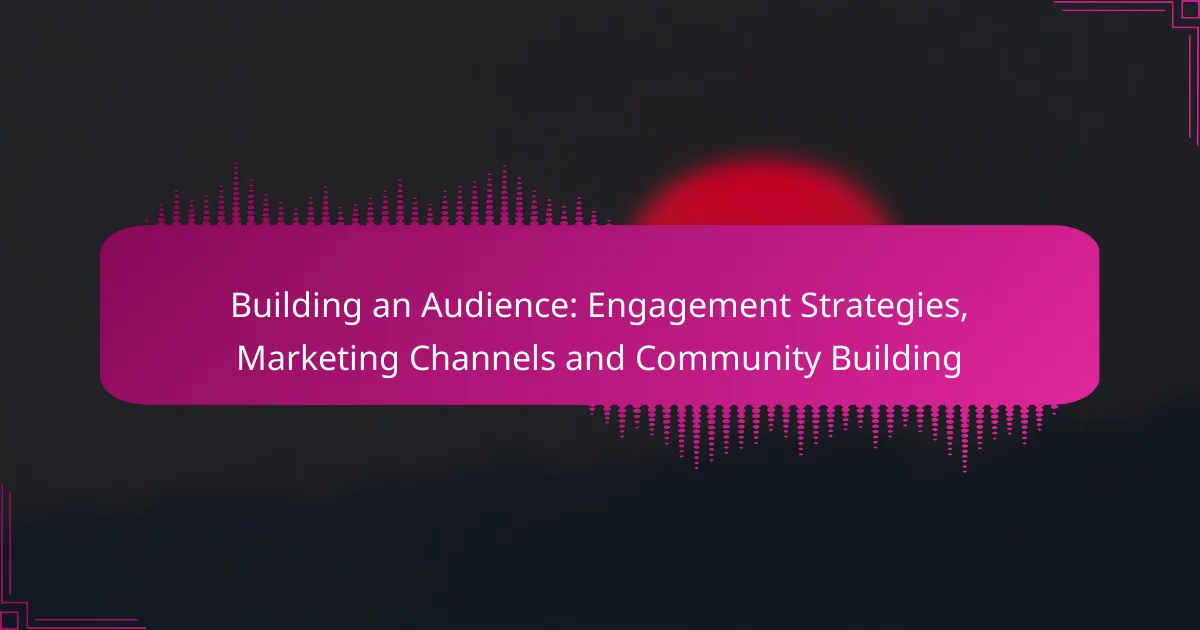Building an audience requires a strategic approach that combines effective engagement strategies, targeted marketing channels, and community-building efforts. By fostering meaningful interactions and creating a sense of belonging, brands can enhance loyalty and encourage organic promotion. Utilizing diverse marketing channels like SEO, social media, and content distribution is essential for attracting and engaging a specific audience, while cultivating a community around your brand amplifies visibility and strengthens connections.
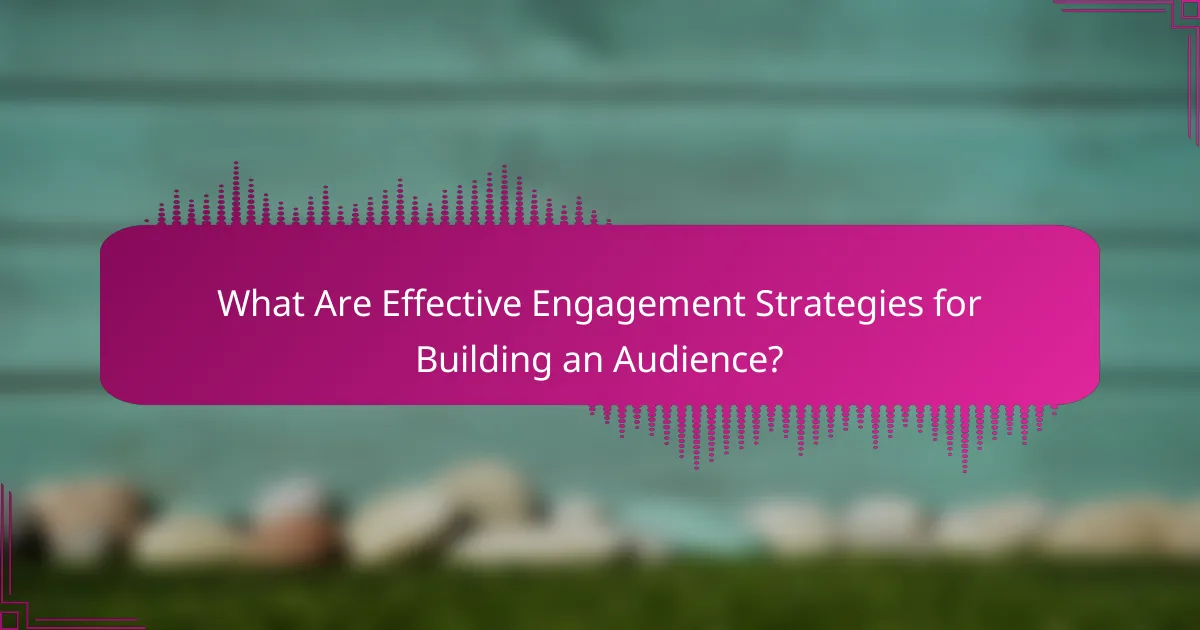
What Are Effective Engagement Strategies for Building an Audience?
Effective engagement strategies for building an audience focus on creating meaningful interactions and fostering a sense of community. These strategies help brands connect with their audience, enhance loyalty, and encourage word-of-mouth promotion.
Content Marketing
Content marketing involves creating valuable and relevant content to attract and engage a target audience. This can include blog posts, articles, videos, and infographics that address the interests and needs of your audience.
To be effective, ensure your content is high-quality and consistent. Utilize SEO best practices to improve visibility and consider using a content calendar to plan and organize your publishing schedule.
Social Media Interaction
Social media interaction is crucial for building an audience, as it allows for real-time engagement with followers. Responding to comments, sharing user-generated content, and participating in conversations can strengthen relationships.
Choose platforms that align with your audience demographics. For example, Instagram and TikTok are popular among younger users, while Facebook may attract a more diverse age range. Regularly post engaging content and use stories or live features to enhance interaction.
Email Campaigns
Email campaigns are an effective way to communicate directly with your audience. By sending newsletters, promotional offers, or personalized messages, you can keep your audience informed and engaged.
Segment your email list to tailor messages to different audience groups. Aim for a consistent sending schedule, such as weekly or biweekly, to maintain interest without overwhelming subscribers.
Webinars and Live Events
Webinars and live events provide opportunities for direct interaction and deeper engagement with your audience. These formats allow for real-time Q&A sessions and discussions, fostering a sense of community.
Promote these events through your website and social media channels. Consider offering incentives, such as exclusive content or discounts, to encourage attendance and participation.
Influencer Collaborations
Collaborating with influencers can expand your reach and credibility. Influencers can introduce your brand to their followers, creating authentic connections and driving engagement.
Choose influencers whose values align with your brand and whose audience matches your target demographic. Establish clear goals for the collaboration, whether it’s increasing brand awareness or driving sales, and track the results to measure effectiveness.
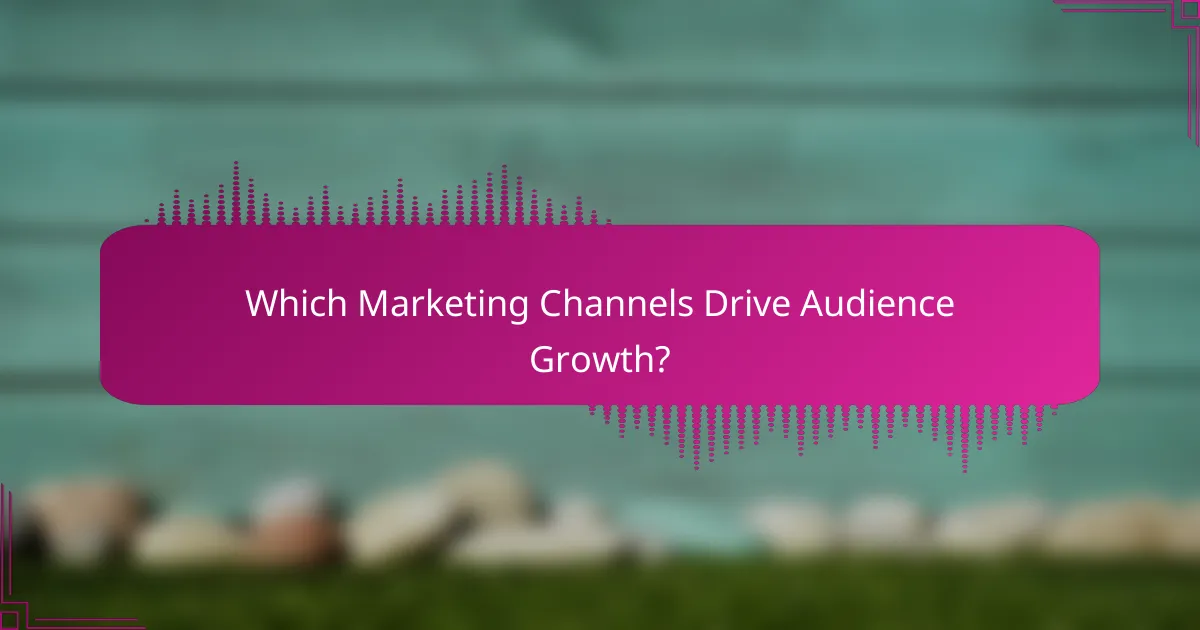
Which Marketing Channels Drive Audience Growth?
Effective marketing channels for audience growth include Search Engine Optimization (SEO), paid advertising, social media platforms, and content distribution networks. Each channel has unique strengths and can be leveraged to attract and engage a target audience.
Search Engine Optimization (SEO)
SEO involves optimizing your website and content to rank higher in search engine results, making it easier for potential audiences to find you. Key strategies include keyword research, on-page optimization, and building backlinks. Regularly updating content and ensuring mobile-friendliness can significantly enhance visibility.
To effectively implement SEO, focus on long-tail keywords that reflect user intent and have lower competition. Tools like Google Analytics and SEMrush can help track performance and identify areas for improvement. Avoid keyword stuffing, as it can lead to penalties from search engines.
Paid Advertising
Paid advertising, such as pay-per-click (PPC) campaigns, allows for immediate visibility and targeted outreach. Platforms like Google Ads and Facebook Ads enable you to reach specific demographics based on interests, location, and behavior. This can lead to rapid audience growth if managed effectively.
When using paid advertising, set clear goals and budgets. Start with small test campaigns to gauge effectiveness before scaling up. Monitor metrics like click-through rates (CTR) and conversion rates to optimize your ads continuously. Avoid overspending by regularly reviewing your ad performance.
Social Media Platforms
Social media platforms are powerful tools for audience engagement and growth. They allow for direct interaction with users and can amplify your content through shares and likes. Popular platforms include Facebook, Instagram, Twitter, and LinkedIn, each catering to different demographics and content types.
To maximize impact on social media, create shareable content and engage with your audience through comments and direct messages. Use analytics tools to track engagement rates and adjust your strategy accordingly. Avoid being overly promotional; focus on providing value to your followers.
Content Distribution Networks
Content distribution networks (CDNs) help deliver your content efficiently across various platforms, enhancing user experience and engagement. They can improve loading times and reduce latency, making your content more accessible. Popular CDNs include Cloudflare and Akamai.
When selecting a CDN, consider factors such as geographic reach, pricing, and integration capabilities. Ensure your content is optimized for different devices and formats to maximize reach. Avoid neglecting performance monitoring; regularly assess how your CDN impacts user engagement and adjust as needed.
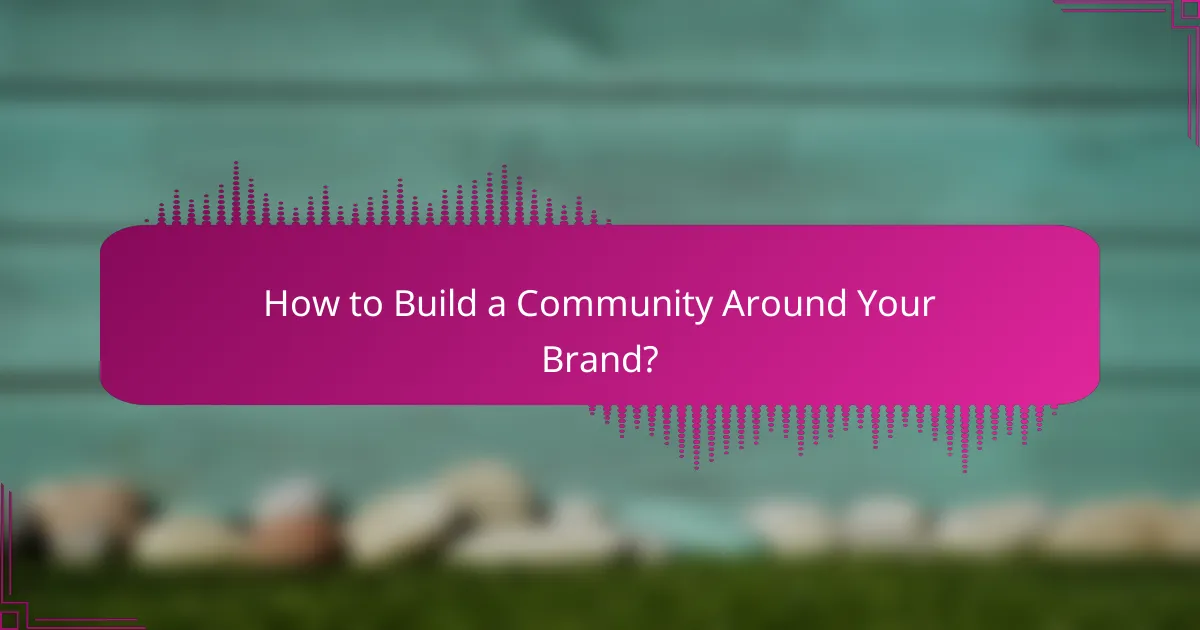
How to Build a Community Around Your Brand?
Building a community around your brand involves creating a space where your audience can connect, share, and engage with your content and each other. This fosters loyalty and encourages word-of-mouth marketing, which can significantly enhance your brand’s visibility and reputation.
Online Forums and Groups
Online forums and groups are essential for fostering community engagement. Platforms like Facebook Groups, Reddit, and specialized forums allow users to discuss topics related to your brand, share experiences, and ask questions. Creating a dedicated space for these interactions can help build a sense of belonging among your audience.
When setting up a forum or group, establish clear guidelines to maintain a positive environment. Regularly participate in discussions to show your commitment and encourage others to engage. Consider hosting live Q&A sessions or themed discussions to keep the conversation flowing.
Engagement through User-Generated Content
User-generated content (UGC) is a powerful way to engage your community. Encouraging your audience to create and share their own content related to your brand can enhance authenticity and trust. This could include photos, testimonials, or reviews that showcase their experiences with your products or services.
To facilitate UGC, consider running contests or campaigns that incentivize participation. For example, you might ask users to share their stories using a specific hashtag on social media. Highlighting this content on your official channels can further motivate others to contribute.
Regular Feedback and Surveys
Regular feedback and surveys are crucial for understanding your community’s needs and preferences. By actively seeking input from your audience, you demonstrate that their opinions matter, which can strengthen their connection to your brand. Simple tools like Google Forms or SurveyMonkey can help you gather insights efficiently.
When conducting surveys, keep them concise and focused on key areas of interest. Share the results with your community to show transparency and how their feedback influences your decisions. Consider implementing changes based on their suggestions to enhance engagement and satisfaction.
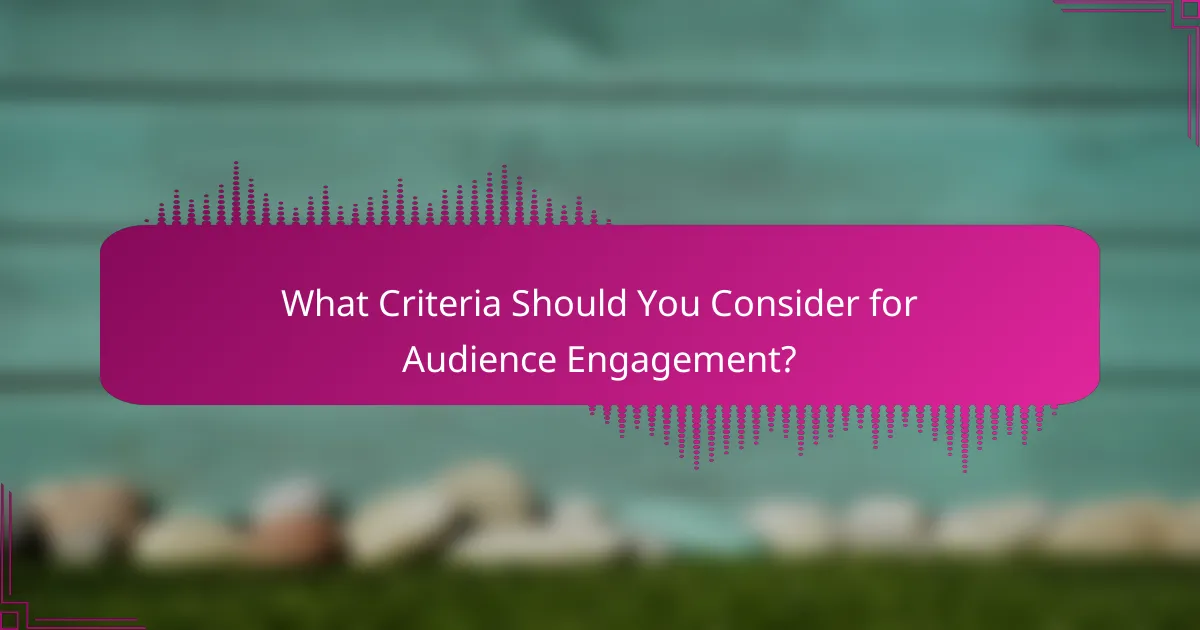
What Criteria Should You Consider for Audience Engagement?
To effectively engage your audience, consider their preferences, behaviors, and demographics. Understanding these criteria will help tailor your content and interactions to foster a deeper connection and encourage ongoing participation.
Target Audience Analysis
Analyzing your target audience involves identifying their interests, needs, and online behaviors. Utilize tools like surveys, social media insights, and website analytics to gather data on who your audience is and what they value. This information is crucial for creating content that resonates with them.
Segment your audience into distinct groups based on characteristics such as age, location, and interests. This allows for more personalized engagement strategies, enhancing the likelihood of interaction and loyalty. For example, younger audiences may prefer platforms like TikTok, while older demographics might engage more on Facebook.
Content Relevance and Quality
Content relevance and quality are vital for maintaining audience engagement. Ensure that your content addresses the specific interests and pain points of your audience. High-quality content should be informative, entertaining, and visually appealing to capture attention effectively.
Regularly update your content to keep it fresh and relevant. Use a mix of formats, such as articles, videos, and infographics, to cater to different preferences. Aim for a consistent posting schedule to build anticipation and encourage regular visits from your audience.
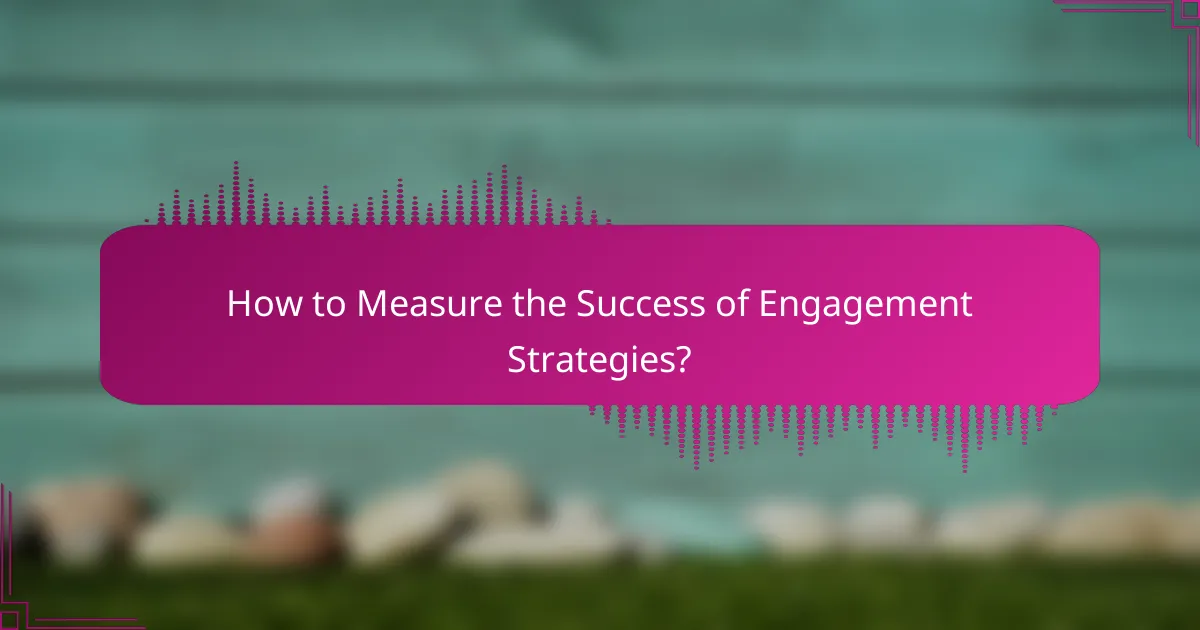
How to Measure the Success of Engagement Strategies?
Measuring the success of engagement strategies involves analyzing various metrics that reflect how well your audience interacts with your content. Key indicators include audience growth, engagement rates, and overall performance against set goals.
Key Performance Indicators (KPIs)
Key Performance Indicators (KPIs) are critical metrics that help evaluate the effectiveness of your engagement strategies. Common KPIs include conversion rates, click-through rates, and social media shares. Establishing clear KPIs aligned with your objectives allows for targeted analysis and informed adjustments.
For example, if your goal is to increase newsletter sign-ups, track the conversion rate from your landing page. A conversion rate of 2-5% is generally considered effective, but this can vary by industry.
Audience Growth Metrics
Audience growth metrics focus on the increase in your audience size over time. This can be measured through new followers, subscribers, or members across various platforms. Tracking these metrics helps you understand the effectiveness of your outreach and marketing efforts.
Consider using a monthly growth rate to assess trends. A consistent growth rate of 5-10% per month is a positive indicator, while stagnation may suggest a need for strategy reevaluation.
Engagement Rates
Engagement rates measure how actively your audience interacts with your content. This can include likes, comments, shares, and time spent on your site. High engagement rates typically indicate that your content resonates well with your audience.
To calculate engagement rates, divide the total engagement actions by the total audience size and multiply by 100. A rate of 1-5% is common for social media platforms, while website engagement may vary widely based on content type and industry.
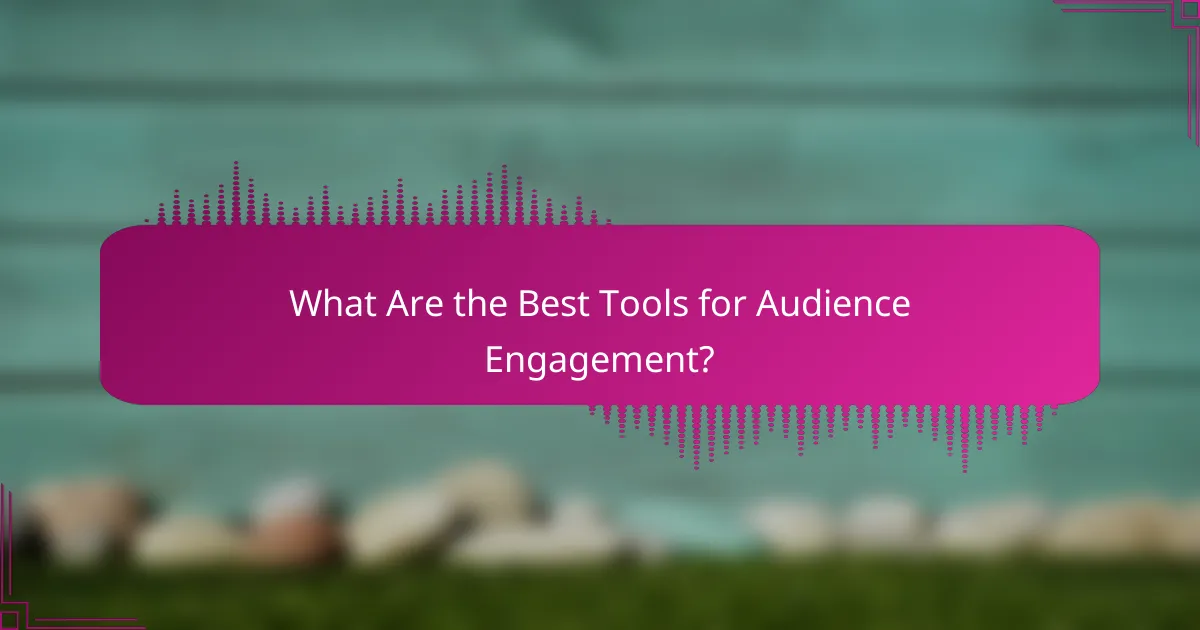
What Are the Best Tools for Audience Engagement?
The best tools for audience engagement include social media platforms, email marketing software, and community management tools. These resources help businesses connect with their audience, foster relationships, and enhance interaction.
Social Media Platforms
Social media platforms like Facebook, Instagram, and Twitter are essential for engaging audiences. They allow for real-time interaction and provide a space for sharing content, responding to comments, and running targeted ads. Choose platforms that align with your audience’s preferences to maximize engagement.
Consider using analytics tools provided by these platforms to track engagement metrics such as likes, shares, and comments. This data can help refine your strategy and identify what content resonates most with your audience.
Email Marketing Software
Email marketing software like Mailchimp or Constant Contact is vital for direct communication with your audience. These tools enable you to send newsletters, promotional offers, and personalized messages. Segmenting your email list can improve engagement by ensuring that content is relevant to each recipient.
Utilize A/B testing to optimize subject lines and content for better open and click-through rates. Aim for a frequency that keeps your audience engaged without overwhelming them, typically once or twice a month.
Community Management Tools
Community management tools such as Discord or Slack facilitate interaction within dedicated groups. These platforms create a sense of belonging and encourage discussions among members. Establish clear guidelines to foster a positive environment and encourage participation.
Regularly engage with community members by hosting Q&A sessions or live events. Monitor discussions to address concerns promptly and maintain a healthy community dynamic. This proactive approach can significantly enhance audience loyalty and engagement.
